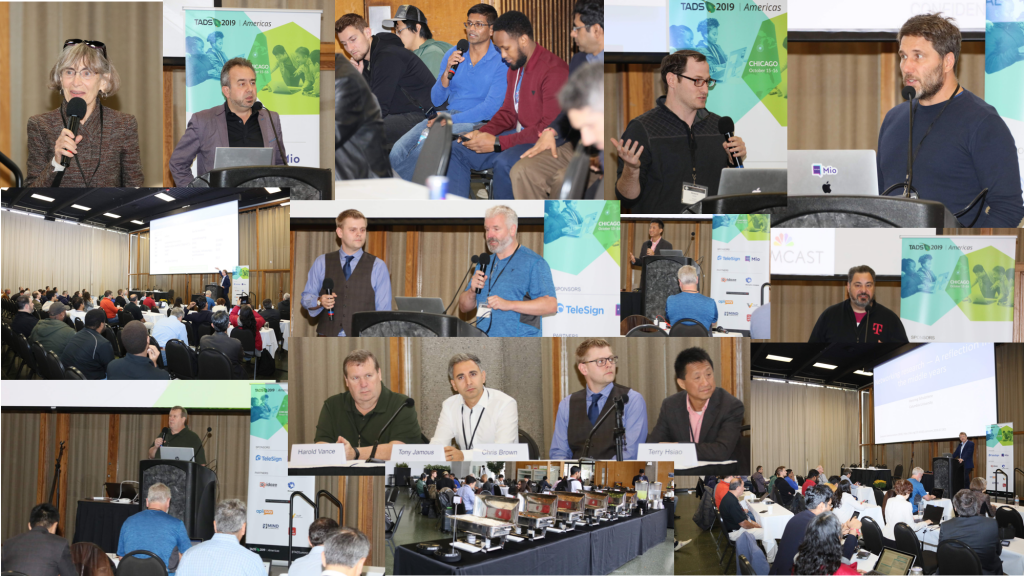TADSummit Americas 2019 ran on the 15-16 Oct, in parallel with the IIT RTC Conference. This weblog provides a summary of the presentations and discussions from TADSummit Americas Day 2 morning.
Thank you to TeleSign and Mio for sponsoring TADSummit Americas, all our partners (VoIP Innovations, Apidaze, IIT RTC Conf, IIT RTC Labs, Mind Commerce, Aplisay, The Fast Mode, Disruptive Analysis), all the world-class presenters, and both the in-person and remote attendees.
We kicked off Day 2 with a session focused on “Case Studies in CPaaS”, which began with Harold Vance on talking about ‘“I’ve Been Everywhere” in CPaaS’. There’s a song by Australian country singer Geoff Mack titled “I’ve Been Everywhere”. When it comes to CPaaS, Harold really has been almost everywhere. He brings unmatched coal-face experience in helping developers, start-ups, small and large established enterprises use CPaaS. Harold will share his insights on what works, what does not, what’s still missing, through lots of case studies from the past decade.
Christopher Brown, CEO and Chairman of Zip911 presented on “Zip911. Create your own emergency network and send automatic, real-time alerts during an emergency”. Established in 2018, Zip911 is a Denver-based 911 provider headed by Chairman and CEO, Christopher Brown. Since serving as a consultant for Fortune 500 companies starting at age 16, Brown has been an innovator in the telecommunications industry for 22 years. Zip911 launched the ground-breaking, real-time alert service, alertTree, in January 2019 and introduced their carrier partner program later in the year. Chris shared his extensive experience in building companies on CPaaS.
The last presentation in this session came from Terry Hsiao, Entrepreneur, Advisor, Investor, and Head of Strategy at Kaleyra on “Experiences with Private (NOT PUBLIC) cloud implementations of CPaaS”. Exploration of private cloud CPaaS use cases around the world. Understanding the benefits and issues of private cloud CPaaS implementations. Discussion of criteria for selecting the best implementation option.
We wrap up the session with a panel discussion on “Closing the Gap with Twilio, What CPaaS Providers Need To Do”.
Panelists:
- Tony Jamous, previously President at Nexmo, the Vonage API Platform, currently investor and advisor
- Terry Hsiao, Entrepreneur, Advisor, Investor, and Head of Strategy at Kaleyra
- Chris Brown, Chairman and CEO Zip911
- Harold Vance, Global Director Customer Success at VoIP Innovations
Questions:
- Should we just give up trying to catch up with Twilio, let them dominate and overcharge?
- Where should be begin in closing the gap? / Where to focus given the diversity of developer needs?
- What are the biggest barriers in your experience in using CPaaS?
- What are the must-have things missing from most CPaaS offers in your experience?
- Will CPaaS be swallowed up by Google, Amazon and perhaps even Microsoft?
The Conference Keynote was given by Henning Schulzrinne Professor at Columbia University, ex-CTO of the FCC on “Networking research — A reflection in the middle years.” This will be one of those seminal lectures where you’ll be able to say you were there!
Networking is no longer a new area of computer science and engineering – it has matured as a discipline and the major infrastructure it supports, the Internet, is long past being primarily a research artifact.
I believe that we should consider ourselves as the civil engineers of the Internet, primarily helping to understand and improve a vast and critical infrastructure. This implies that implementing changes takes decades, not conference cycles, and that implementation is largely driven by compatibility with existing infrastructure and considerations of cost effectiveness, where resources that research focuses on, such as bandwidth and compute cycles, often play a much smaller role than limited organizational capacity for change.
Telecommunications carriers, in particular, have become akin to airlines, largely operating equipment designed by others, with emphasis on marketing, not innovation. Even more than in other engineering disciplines, standards matter, whether set by standards bodies or dominant players.
Given the multi-year time frames of standards and the limited willingness of national funding bodies to support standardization work, this makes research impact harder, as does the increasing complexity of cellular networks and barriers to entry that shut out most researchers from contributing to large parts of commercial mobile networks.

